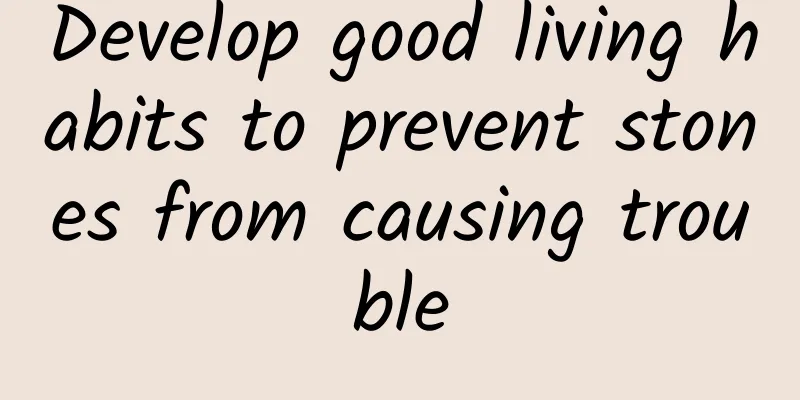Develop good living habits to prevent stones from causing trouble

|
This is the 3763rd article of Da Yi Xiao Hu Sweating, in agony, crying and shouting, this is not some doomsday movie propaganda, but just a common disease in life - "kidney stones". With the continuous changes in people's lifestyles and dietary structures, the incidence of kidney stones is also quietly increasing. The pain caused by kidney stones is very severe, and patients often roll on the ground. So what exactly are kidney stones, and how can we prevent and avoid kidney stones? Let's take a look at kidney stones and take a look at its past and present. Low back pain caused by kidney stones 1. What are kidney stones? Kidney stones are a common clinical disease caused by the abnormal accumulation of crystal substances such as cystine, uric acid, oxalic acid, and calcium in the kidneys. The most common stones are calcium oxalate stones. Kidney stones 2. Symptoms of kidney stones Common symptoms of kidney stones include hematuria, abdominal distension, irritability, nausea, vomiting, and cramps in the waist and abdomen, which may also be accompanied by chills or fever. Sometimes, patients do not feel pain, but have very small amounts of blood in their urine, which is generally invisible to the naked eye. When combined with infection, there will be symptoms of frequent urination and urgency. If not treated in time, it is likely to cause urinary tract infection, which in turn causes urinary tract obstruction. Severe cases may also damage their own renal function and cause renal parenchyma atrophy. Symptoms of kidney stones 3. The formation process of kidney stones The formation of kidney stones starts from the core of the stone, and the core of the stone is composed of particles filtered and precipitated by the migration of crystals. A few stones are composed of blood clot cell clusters, mainly shed epithelial cells and various foreign bodies in the water, including salts, which gradually precipitate around the core of the stone with the participation of the liquid matrix, gradually expand and form stones. The formation of kidney stones is very complicated. The crystals in the urine, such as calcium and phosphate ions or cystine, uric acid, magnesium ammonium phosphate and apatite, increase, exceeding the solubility in the urine, presenting a supersaturated state, and gradually forming stones after the appearance of crystal nuclei. Types of Kidney Stones 4. Conditions that predispose you to kidney stones Kidney stones, like other diseases, do not occur randomly; their occurrence is related to certain specific conditions. Conditions that predispose to kidney stones (The correct number indicates that the disease is likely to occur, and the wrong number indicates that the disease is not likely to occur) (1) Gender The incidence of kidney stones in men is higher than that in women. This may be related to the work that men do, because men are more likely to engage in physical labor, which causes long-term excessive sweating, insufficient water intake, intake of high-protein and high-fat foods, and large food intake; in addition, male androgens increase the formation of oxalic acid, while female estrogens can increase the excretion of oxalic acid in urine, which can inhibit the formation of calcium stones in urine. (2) Eating habits Dietary habits are closely related to the incidence of kidney stones • Excessive fat intake Excessive fat intake is likely to cause a gradual increase in body fat. The increased fat will affect the calcium in the human intestine, causing it to gradually decrease, which in turn leads to a gradual increase in the absorption of oxalate. Therefore, when excretion function failure occurs, such as low urine output, low water intake, and excessive sweating, kidney stones are likely to occur in this case. • Sugar intake Excessive intake of sugar, especially lactose, can lead to increased calcium absorption and increased oxalic acid concentration, causing calcium oxalate to accumulate in the body and ultimately leading to the formation of urinary stones. • Excessive protein intake Excessive protein intake may gradually increase the uric acid, oxalic acid and calcium in the patient's urine and kidneys. If the kidney function cannot be used in a timely and effective manner to excrete excess uric acid, oxalic acid and calcium from the body, it may trigger the conditions for kidney stones and ureteral stones. This is also the reason why the incidence of kidney stones has increased as the quality of life of modern people has improved. (3) Drinking water Increasing water intake can increase urine volume, thereby reducing the supersaturation of crystals in urine, enhancing the dilution and dissolution of metabolites and the flushing of the urinary tract, which is conducive to the timely excretion of small stones and has a positive effect on preventing the formation of various types of stones. The results of the study showed that the average daily water intake is a protective factor for the occurrence of urolithiasis. When the water intake is greater than 2000ml/d, the incidence of kidney stones can be significantly reduced, and the proportion of patients with water intake less than 1000ml/d increases significantly. Therefore, drinking more than 2000ml/d is beneficial to prevent the occurrence of kidney stones. (4) History of urinary tract infection During urinary tract infection, bacteria become the core of stone formation and are an important risk factor for kidney stone formation. Certain bacteria, such as Proteus, can produce a urease that decomposes urea to increase urine pH, causing calcium and other substances to become supersaturated and precipitate, wrapping around the surface of bacteria and forming stones. Clinical statistics show that the prevalence of kidney stones in patients with a history of urinary tract infection is significantly higher than that in patients without a history of urinary tract infection. 5. How to prevent kidney stones • Drink plenty of water • Proper calcium supplementation • Limit sugar intake • Eat less foods high in oxalate • Eat less soy products • It is best not to drink milk before going to bed • Do not overdose on cod liver oil • Eat more black fungus • Increase your daily activity 6. Common misunderstandings about kidney stones (1) Is kidney stones always painful? If they don’t hurt, they are not kidney stones. Some patients with kidney stones do not have symptoms of pain, but they will have symptoms of very small amounts of blood in their urine, which is generally invisible to the naked eye. Once an infection occurs, symptoms of frequent urination and urgency will appear, which must be taken very seriously, otherwise it may lead to infection and obstruction of the urinary tract, or even kidney damage. (2) Will drinking more water definitely cure kidney stones? Kidney Stone Size (1) Kidney Stone Size (2) The principle of drinking water to expel stones is to increase water intake and enhance the excretion function of the kidneys. However, not all stones can be excreted smoothly through urine. • Smaller kidney stones: Usually, kidney stones less than 0.6 cm, with no obstruction or secondary infection in the distal urinary tract, can be treated with conservative methods, such as drinking more water, exercising appropriately, and taking oral drugs to treat stones. • For relatively large kidney stones: for example, kidney stones larger than 1 cm cannot be discharged from the body through the ureter on their own, extracorporeal shock wave lithotripsy can be chosen for treatment; extracorporeal shock wave lithotripsy is a non-surgical treatment method that mainly locates the stones in the body through B-ultrasound or X-rays, focuses high-energy shock waves on the stones, breaks them up, and discharges the crushed stones through the ureter; you can also choose internal lithotripsy, which is a surgical treatment method that mainly uses a ureteroscope to crush the stones; the ureteroscope enters the renal pelvis along the urethra and ureter, crushes the stones after finding them, and removes them through a stone basket; • Kidney stones that are too large: For example, kidney stones larger than 2 cm, percutaneous nephrolithotomy, a surgical treatment method, can be chosen to treat the stones. Therefore, not all stones can be cured by increasing water intake and exercising appropriately. It is necessary to choose the appropriate treatment method based on the condition of the stones to avoid missing the best time for treatment. (3) Can calcium supplementation be used to treat kidney stones? Can calcium supplementation cause kidney stones? The most common kidney stones are calcium oxalate stones, so many people think that calcium supplementation will cause or prevent kidney stones. In fact, it is just the opposite. Through reasonable calcium supplementation, oxalate combines with calcium ions in the digestive tract to form calcium oxalate precipitation, which is excreted from the body with feces, reducing the incidence of kidney stones. References [1] Zhao Defang, Jin Lihong, Jin Lixin. Brief analysis of the mechanism, causes and prevention of kidney stones[J]. Chinese and Foreign Health Digest, 2008(22):85-85. [2] Maimaitijiang Dawuti. Analysis of the causes of kidney stones[J]. Medical Information, 2013(14):134-134. [3] Feng Jie. Causes and precautions of kidney stones[J]. Special Health, 2020(1):24-25. [4] Yang Sasa. Writing skills for popular medical articles[J]. Office Business, 2022(4):5-6. Author: Tongji University School of Medicine Miao Yongen |
>>: Why do people suffer from insomnia?
Recommend
Pressure therapy is crucial for “old leg ulcers”. What should you pay attention to when applying bandages and wearing elastic stockings?
Author: Zhang Xin, Head Nurse, Beijing Tongren Ho...
Can I eat mutton after abortion?
Nowadays, women lack the awareness of caring for ...
Do uterine fibroids affect fertility?
The uterus is a reproductive organ unique to wome...
Beware of "height-increasing product" scams and understand height growth scientifically
Author: Huang Yanhong Duan Yuechu In today's ...
8 ways to balance your endocrine system
Every time my old friend had irregular periods an...
Can pregnant women eat cherries in the early stage
Many women experience a loss of appetite and are ...
How to deal with endometrial separation
In daily life, many people, due to their open min...
Why did AIDS not exist in ancient times but only appeared in modern times? Discuss the origin and prevention of AIDS
Since AIDS was discovered in the United States on...
Symptoms and treatment of balanitis
Balanitis is a common reproductive disease in men...
Breastfeeding for six months and less milk
When breastfeeding is six months old, the amount ...
To be honest! This eye disease must be treated while it is hot!
In most people's minds, crying is a physiolog...
What to do if the nipple base repeatedly cracks during lactation
During breastfeeding, women's nipples are pro...
Will I be deformed if I don't avoid certain foods during pregnancy?
Families with eugenics plans have a preparation f...
What to do if you have phlegm in your throat during pregnancy
If we have phlegm in our body, it is a manifestat...
Effects of folic acid on the skin
Folic acid is an essential substance for the huma...









